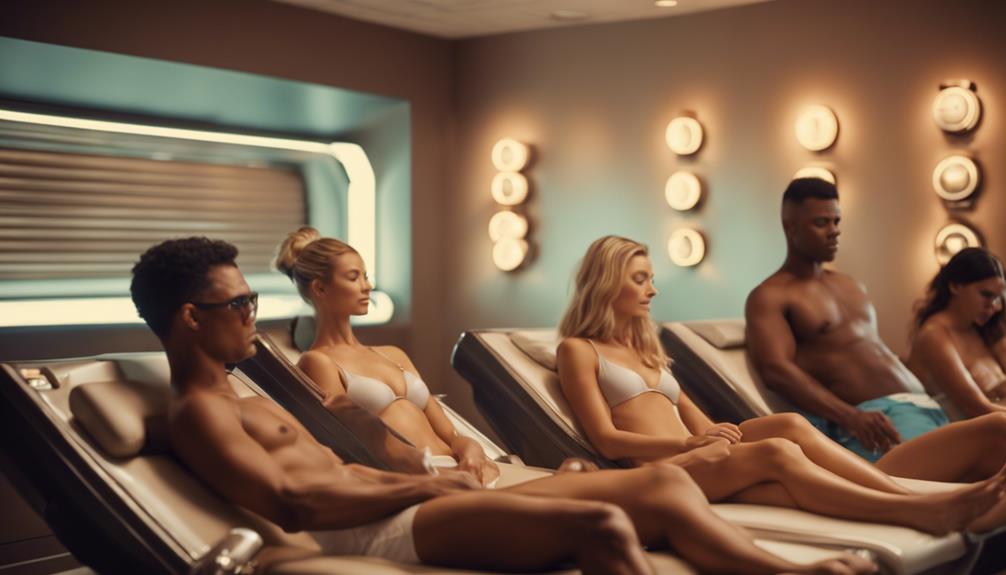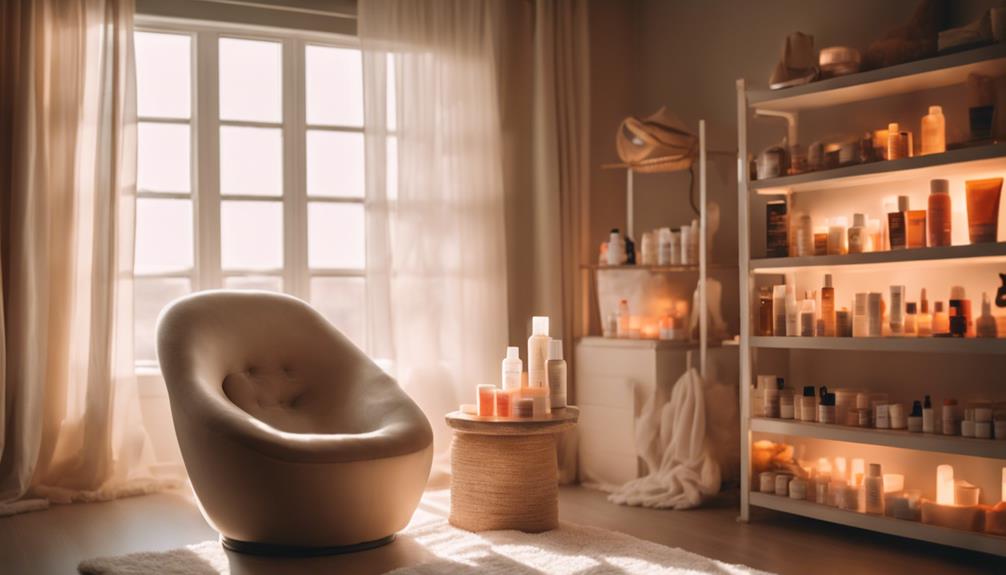Getting the perfect tan depends a lot on your skin type! If you're a fair Type 1, start with just 1-3 minutes to avoid turning into a lobster. Type 2 can handle 2-4 minutes, while Type 3 works best with 4-8 minutes. Got that gorgeous olive glow of Type 4? You can go for 4-9 minutes! Finally, Type 5 can kick it off with 4-10 minutes. And don't forget to listen to your skin—if it feels uncomfortable, it's time to take a break. Who knew tanning could be so complicated? Stick around to learn more about keeping that tan safe!
Key Takeaways
- Type 1 skin should start with 1-3 minutes to prevent burns during initial tanning sessions.
- Type 2 skin can gradually increase exposure, beginning with 2-4 minutes for safe tanning.
- For Type 3 skin, recommended tanning duration is 4-8 minutes to achieve optimal results.
- Type 4 skin can handle 4-9 minutes, benefiting from its natural olive tone for tanning.
Skin Type Overview
Understanding your skin type is essential for safe and effective tanning, as it influences how your skin reacts to UV exposure and how you should approach tanning sessions.
So, what's your skin type? If you've got Type 1, you burn faster than toast! Type 2 can tan but still needs to be careful, while Type 3 has a bit more luck with tanning.
Type 4? You're rocking that olive tone, and Type 5's are practically sun-proof.
But remember, just because you can tan doesn't mean you should plunge in for hours! Each skin type has its own quirks, so knowing yours helps you avoid that dreaded lobster look.
Don't you want a glow, not a burn? Tanning smart is the way to go!
Tanning Recommendations

Knowing your skin type sets the stage for effective tanning recommendations tailored to your unique needs.
If you've got Type 1 skin, start with just 1-3 minutes. Yes, just a few minutes!
For Type 2, aim for 2-4 minutes—think of it as dipping your toes in the water.
If you're Type 3, you can handle 4-8 minutes, but don't rush it; gradual exposure is key!
Type 4? You can start with 4-9 minutes—lucky you!
For Type 5, kick things off with 4-10 minutes, but keep an eye on your skin.
Remember, everyone's different, so listen to your body. Tanning should be fun, not a sunburn competition, right?
Happy tanning, and don't forget the lotion!
Tanning Bed Guidelines

When using tanning beds, always start with shorter sessions to allow your skin to adjust safely. Think of it like dipping your toes into a pool; you wouldn't jump in headfirst, right? For most skin types, sticking to 5-10 minutes at first is smart.
Don't forget your protective eyewear—those UV rays can be harsh on your eyes! Using a good tanning lotion helps keep your skin hydrated and can prevent dryness.
Plus, keep an eye on how your skin reacts. If it feels too hot or looks red, it's time to take a break. Remember, tanning is meant to enhance your look, not turn you into a lobster!
Safety first, and then you can flaunt that glow!
Tanning Schedule

After establishing safe tanning practices, creating a tanning schedule tailored to your skin type guarantees ideal results while minimizing the risk of burns.
So, what does that look like?
If you're Type 1, start with just 1-3 minutes—yes, that's shorter than your TikTok break!
Type 2 can kick off with 2-4 minutes, while Type 3 should aim for 4-8 minutes.
Got that olive glow? Type 4 can handle 4-9 minutes.
And if you're blessed with Type 5 skin, begin with 4-10 minutes.
Just remember, no one wants to look like a lobster!
Gradually increase your time, always listen to your skin, and don't forget that tanning lotion—it's your BFF in this tanning journey.
Happy tanning!
Safe Tanning Practices

To guarantee a safe tanning experience, always prioritize protective measures like eyewear and tanning lotion. You want to rock that glow, not end up looking like a lobster!
Here are some essential tips to keep in mind:
- Always wear protective eyewear to shield your eyes from harmful UV rays.
- Use a high-quality tanning lotion to keep your skin hydrated and protected.
- Start with shorter sessions to see how your skin reacts before diving into longer ones.
Addressing Common Concerns

Addressing common concerns about tanning can help guarantee you make informed decisions for a safer experience. You might wonder, “Will I burn?” or “How long should I tan?”
The truth is, knowing your skin type is key! If you've got fair skin, you'll need to take it slow—think short sessions. And don't forget those protective goggles; your eyes deserve a break from those UV rays!
Ever tried tanning lotion? It's not just for show; it keeps your skin hydrated and happy. If you feel any discomfort, it's time to hit pause!
Alternatives to Tanning Beds

Exploring alternatives to tanning beds can help you achieve a sun-kissed look while minimizing skin damage and health risks. Who wants to risk their skin for a tan, right? Here are some fun options to contemplate:
- Self-Tanning Lotions: These give you a beautiful glow without the UV rays! Just apply and wait for the magic.
- Spray Tans: Perfect for a quick tan! They're usually even and can last a week or so.
- Bronzing Makeup: Instant tan? Yes, please! Just apply and wash off when you're done.
With these alternatives, you'll get that gorgeous tan while keeping your skin healthy and happy!
Trending Tanning Topics

With a variety of tanning alternatives available, staying updated on the latest trends in tanning products and practices can enhance your tanning experience and keep your skin health in check.
Have you heard about the must-have tanning lotions? They hydrate your skin while giving you that sun-kissed glow!
And what about protective gear? Goggles aren't just stylish; they save your eyes from those sneaky UV rays.
Plus, prepping your skin before tanning? It's a game-changer!
You'll want to check out the buzz on proper tanning bed cleaning, too. Keeping everything spick and span is essential!
Frequently Asked Questions
How Often Should I Tan Each Week for Best Results?
You should tan about 2-3 times a week for best results. This allows your skin to develop gradually without risking burns. Always monitor your skin's response and adjust frequency as needed for ideal health.
Can I Use Makeup Before a Tanning Session?
Absolutely, you can wear makeup before tanning, but it might feel like painting a masterpiece on a canvas that's about to get messy. Just guarantee it's light and easy to remove afterward for the best results!
What Should I Do if I Miss a Tanning Session?
If you miss a tanning session, don't stress! Just resume your routine at the next scheduled time, and consider adjusting your duration slightly to maintain your desired tan without overexposing your skin.
Are There Specific Foods That Help With Tanning?
Yes, certain foods can help with tanning. Incorporate carrots, tomatoes, and spinach into your diet. These foods boost your skin's natural pigmentation and provide antioxidants, enhancing your tan while keeping your skin healthy.
How Can I Tell if My Skin Is Overexposed?
You can tell your skin's overexposed if it feels hot, looks red, or starts peeling. Pay attention to discomfort or tightness, and remember to take breaks, staying hydrated to help your skin recover.
Conclusion
So, there you have it! With the right knowledge about your skin type, you can soak up the sun safely and strut around with that gorgeous glow.
Isn't it funny how we all want to look like we just got back from a tropical vacation?
Just remember to listen to your skin, take it slow, and don't skip the sunscreen.
With these tips, you'll be ready to shine like the sun—without the painful burn!
Happy tanning!










